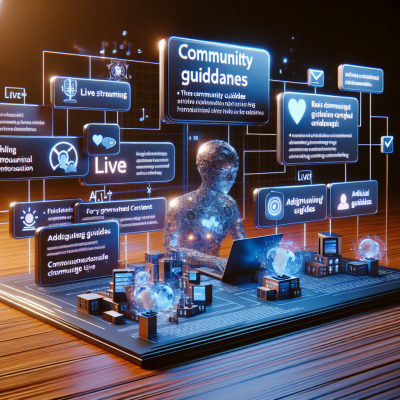
Introduction
TikTok, the global short-form video platform, has once again amended its Community Guidelines, aiming to strike a balance between creative expression, platform safety, and technological advancement. Announced in August 2025, these subtle yet influential updates cover areas including live content moderation, AI-generated media, synthetic influencers, and creator accountability. While some changes may fly under the radar, they reflect TikTok’s strategic response to evolving user behaviors and content trends.
In this post, we break down what the new guidelines mean for creators, especially those who produce live content or use AI-powered content tools.
Key Updates to TikTok’s Community Guidelines
TikTok’s Community Guidelines aren’t new—they’re revised periodically to ensure the platform upholds safety, creativity, and ethical integrity. However, this new revision includes notable clarifications, particularly for live creators and AI-enhanced content.
1. Enhanced Policies Around Live Content
With TikTok Live becoming a hub for real-time interaction, the platform is now placing stronger emphasis on managing live-stream behavior. Here’s what creators should be aware of:
- Live Access Eligibility: Hosts must now meet stricter eligibility requirements—including a threshold for follower count and age verification.
- Behavioral Standards: Any form of nudity, harassment, or misinformation in live broadcasts will be met with stricter penalties, including permanent bans.
- Real-time Moderation Tools: TikTok is enhancing automated and manual review systems to instantly flag rule-breaking behavior during live sessions.
These changes make it imperative for livestream creators to stay informed and cautious, especially when hosting audience-driven content.
2. Stricter Rules on AI-Generated Content
As AI tools become increasingly integrated in content creation, TikTok’s guidelines now explicitly address AI-generated media to curb misinformation and protect authenticity:
- Labeling Requirement: Any content created with AI—including voice clones and image generation—must clearly indicate this status using TikTok’s new AI labeling tools.
- Synthetic Media Limitations: Creators cannot use AI to impersonate individuals or simulate political, medical, or legal communications without consent or context.
- Ban on Deceptive Deepfakes: Misleading or manipulated deepfake content that causes harm or spreads false narratives will result in removal and potential account suspension.
TikTok also added an educational section within its guidelines to help creators understand how to use AI ethically and responsibly.
3. Accountability and Creator Education
Another subtle—yet impactful—shift lies in how TikTok plans to work with creators more proactively to prevent violations:
- Strike Transparency: Strike-based systems are now more transparent, letting users see strikes and warnings directly in their account dashboards.
- Safety Tutorials: Before regaining access after a violation, creators may be required to watch short safety tutorials or pass a content quiz.
- Community Collaboration: TikTok has begun piloting feedback channels where high-profile creators can contribute to future policy shaping.
These initiatives aim to turn the enforcement system into a more educational and rehabilitative process instead of a purely punitive one.
Why the Changes Matter Now
With over a billion active users, TikTok’s influence spans cultural trends, political dialogue, and digital identity. The platform isn’t merely responding to isolated incidents—it’s addressing a deeper systemic need for transparency, trust, and platform health as the app continues to grow globally.
The rise of generative AI, for instance, has both enabled new formats of creative exploration and introduced unprecedented avenues for manipulation and unethical media usage. Likewise, livestreaming on TikTok has brought creators closer to their audiences, but also challenged the boundaries of moderation.
By implementing these newly refined guidelines, TikTok is making a clear statement: creativity and safety should go hand in hand.
The Role of Technology in Enforcement
To support the new rules, TikTok is expanding its use of AI-based moderation tools that can:
- Scan live streams for policy violations in real time
- Detect and remove filtered or AI-generated deceptive content
- Automatically flag accounts showing a pattern of abusive behavior
These advancements come amid wider scrutiny around tech platforms and their responsibility in tracking content violations without infringing on user privacy.
Final Thoughts: What Creators Should Do Now
These guideline updates may seem minimal at a glance, but their implications are far-reaching, especially for creators who rely heavily on live content and AI tools. To stay compliant and maintain a strong presence on TikTok, creators should:
- Regularly review the updated Community Guidelines
- Use TikTok’s labeling tools for any AI-generated or modified content
- Practice ethical content creation, especially when dealing with sensitive topics or impersonations
- Engage with the platform’s new educational tools to gain clarity on evolving rules
Ultimately, TikTok is creating a more secure and transparent environment—for creators, brands, and audiences alike. Embracing these changes may not only help safeguard your account but could also be key to thriving on the platform in the long run.
Stay Ahead of the Curve
As TikTok continues to evolve in real-time with the shifting digital media landscape, so must its creators. Whether you’re going live, experimenting with AI, or just building your niche audience, revisiting and understanding these subtle shifts can ensure you remain compliant—and ahead of the competition.
For more social media tips and the latest updates on creator economy platforms, subscribe to our newsletter or follow our blog.


Leave a Reply